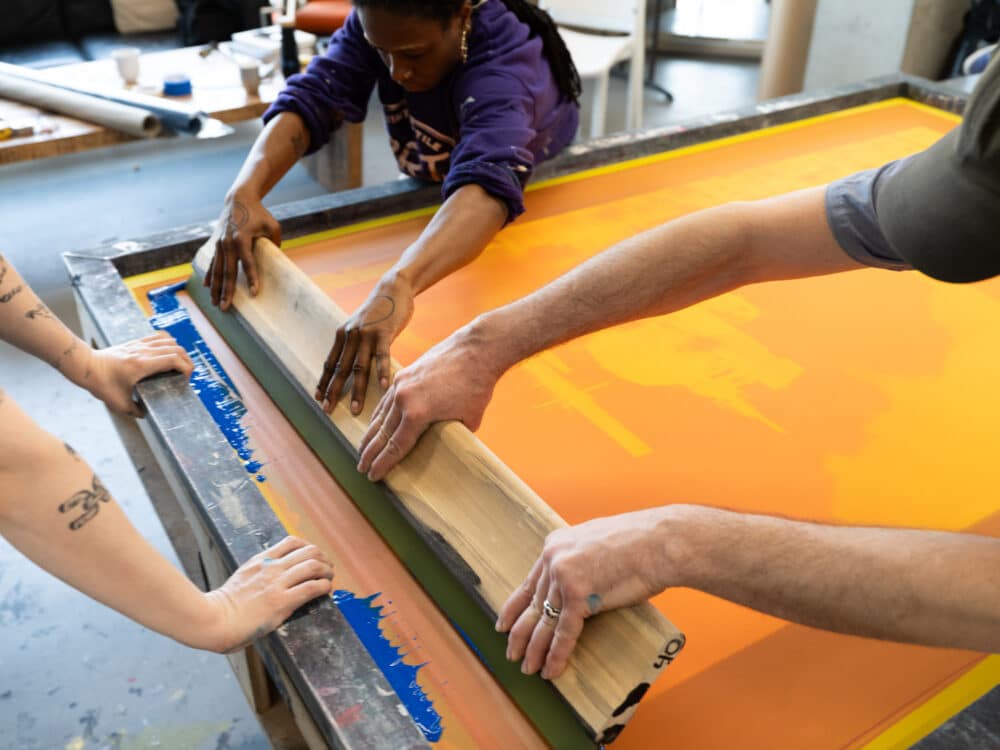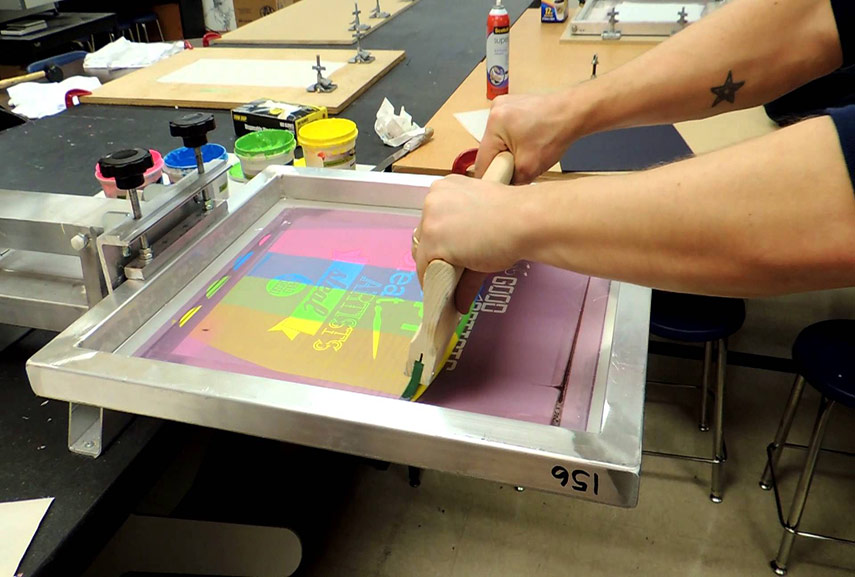Screen Printing curing and finishing methods to guarantee long-lasting quality
From Design to Shipment: Mastering the Art of T-Shirt Screen Printing
The journey from style to shipment in t-shirt screen printing encompasses a series of critical points that require focus to information and tactical planning. It begins with recognizing the nuances of your target market, complied with by the option of proper materials and the preparation of art work that satisfies high criteria. As the procedure unfolds, obstacles in high quality control and logistics can occur, possibly influencing the final outcome. Checking out these complexities reveals not just the intricacies of screen printing but likewise the crucial techniques that can raise a brand's standing in a competitive market.
Comprehending T-Shirt Screen Printing
Understanding T-Shirt screen printing includes identifying a flexible and extensively utilized approach for moving designs onto material. This strategy uses a mesh and a pattern screen to use ink onto numerous textile materials, mostly cotton and polyester blends. The procedure begins with the development of a display that includes the preferred design, which is then thoroughly lined up on the material.
Ink is pressed through the screen's open areas utilizing a squeegee, permitting specific application of shade. This technique is preferred for its ability to create lively, lasting prints that stand up well to washing and put on. In addition, screen printing is capable of accommodating both straightforward and complicated designs, making it a preferred choice for personalized garments, promotional items, and even imaginative jobs.
Screen printing uses scalability, making it ideal for both small set orders and massive productions. While initial configuration expenses might be higher compared to various other printing techniques, the performance and sturdiness of screen printing commonly validate the investment. In general, recognizing the basics of T-shirt screen printing is essential for any individual looking to participate in this popular form of textile decoration, whether for business undertakings or individual projects.
Conceiving Your Style
Conceptualizing your design is an essential action in the T-shirt screen printing procedure, as it establishes the foundation for the entire project (T-Shirt Printing). This phase includes creating ideas that resonate with your target audience while guaranteeing that the layout aligns with the brand's identity and message. It is vital to start by checking out themes, color design, and graphics that show the intended aesthetic
Mapping out initial ideas can be valuable, allowing for a visual representation of ideas prior to completing the style. Take into consideration making use of typography, imagery, and design in a method that catches focus and interacts efficiently. On top of that, it is essential to prepare for the printing technique that will be utilized, as this can affect design intricacy and shade options.
Participating in brainstorming sessions with employee or seeking responses from possible clients can additionally improve the concept process, supplying diverse point of views that fine-tune the style. Eventually, a well-thought-out layout not only improves the aesthetic allure of the T-shirt but additionally promotes a link with the target market, driving rate of interest and prospective sales. As a result, devoting time to conceive your style can bring about an effective screen printing end result.
Picking the Right Products

The weight of the material, typically gauged in grams per square meter (GSM), affects the drape and total feel of the Tees. Larger fabrics might supply a more exceptional appearance, while lighter options are comfortable for laid-back wear. Structure also contributes; smoother fabrics often tend to produce sharper prints, while distinctive surfaces can develop distinct visual impacts.
Additionally, take into consideration the ecological impact of materials. Organic cotton and recycled polyester are acquiring appeal amongst eco-conscious consumers. Ultimately, picking the best materials involves stabilizing aesthetic charm, functionality, and sustainability, making certain that the T-shirt not just looks fantastic yet likewise meets the assumptions of your target audience.
Preparing Art Work for Printing
Preparing art work for T-shirt screen printing requires careful interest to detail to assure that the last print accurately mirrors the designated layout. The initial step is to create a high-resolution digital data, ideally in vector layout, as this enables scalability without loss of high quality. Common software application utilized for this objective consists of Adobe Illustrator and CorelDRAW.
Next off, validate that all message is transformed to details or rasterized to avoid font issues during printing (Abilene T-Shirt Screen Printing Company). Furthermore, it is crucial to verify that the shade setting is established to CMYK, as this aligns 10:9 Design Business Branding Solutions with the printing procedure. Pay attention to shade matching; making use of Pantone shades can help achieve consistency throughout various prints
Consider the measurements of the print area and maintain proper margins to prevent layout cutoff. It's additionally smart to consist of enrollment marks for positioning throughout the printing procedure. Screen Printing. Lastly, demand an evidence from the printer to picture the end product prior to mass manufacturing. This action is necessary for recognizing any type of potential problems, ensuring that the printed Tee shirts meets the desired quality and layout requirements. Proper prep work of art work greatly affects the general success of the screen printing task
Mastering the Printing Process
Understanding the printing procedure is important for accomplishing premium cause T-shirt screen printing. This stage includes numerous substantial actions that straight affect the final product. The primary step is establishing the printing press accurately. Proper enrollment of screens assurances that colors line up appropriately, stopping misprints and assuring a specialist look.
Next, selecting the right ink is very important. Various ink types, such as plastisol or water-based, offer various finishes and durability. Recognizing the material structure of the Tees likewise assists in choosing suitable inks.
Regulating the squeegee pressure and angle is important when it comes to the real printing. Constant pressure will produce also ink circulation, while the angle influences the flow and coverage. In addition, adjusting the rate of the printing press can influence the ink's curing procedure, which is essential for assuring toughness.
Quality Assurance and Finishing
After the printing process is complete, applying reliable quality assurance procedures ends up being important to validate that each T-shirt fulfills the preferred requirements. Quality assurance entails a methodical approach to evaluating each garment for flaws, confirming that the print top quality, shade accuracy, and textile integrity straighten with the specs set throughout the layout phase.

The primary step in quality assurance is a detailed aesthetic examination. This requires monitoring for common problems such as imbalance, ink smudges, or fading. Any type of Tees that does not satisfy the top quality criteria must be addressed without delay, either with reprinting or fixing.
Along with visual checks, it is crucial to conduct wash tests on an example of printed t-shirts to examine the resilience of the inks and the general longevity of the layout. These tests assist validate that the print will maintain its vibrancy and honesty after several cleans, a necessary factor for customer fulfillment.
Finishing touches, such as string cutting and the application of treatment labels, additionally play a substantial role in quality assurance - Business Branding Services. By focusing on these facets, organizations can boost the general presentation of their items, inevitably causing an extra satisfying customer experience
Packaging and Delivery Solutions

To attain optimal packaging, consider making use of environment-friendly materials that align with sustainability patterns, such as recyclable poly bags or naturally degradable boxes. Each Tees ought to be neatly folded and put in safety covering to avoid creasing and potential damages during transportation. Consisting of a well-known insert or treatment directions can even more individualize the experience, cultivating client loyalty.
Selecting a reliable delivery companion is vital when it comes to distribution. Examine alternatives based on speed, price, and tracking abilities. Supplying several shipping methods can cater to various customer needs, from basic to expedited delivery.
Regularly Asked Inquiries
What Are the Typical Mistakes Newbies Make in Screen Printing?
Common mistakes novices make in screen printing include inappropriate screen prep work, poor ink mixing, incorrect direct exposure times, not enough treating, and overlooking to evaluate prints. These mistakes can cause low quality and unacceptable lead to last products.
How Can I Prevent Ink From Blood Loss During Printing?
To stop ink bleeding throughout printing, guarantee appropriate screen tension, usage ideal solution density, pick the right ink consistency, maintain optimal healing temperature levels, and prevent overloading the screen with extreme ink during application.
What Types of Inks Are Ideal for Various Fabrics?
Choosing inks based on fabric type is necessary. Water-based inks are excellent for cotton, providing soft qualities. Plastisol inks fit synthetic fabrics, supplying sturdiness. Discharge inks successfully blend with all-natural fibers, guaranteeing vivid colors without compromising fabric integrity.
Exactly how Do I Pick the Right Screen Mesh Count?
Choosing the appropriate screen mesh matter relies on the preferred print information and ink kind. Abilene T-Shirt Screen Printing Company. Greater mesh matters generate better information, while lower counts assist in thicker inks. Assess material kind and layout intricacy for ideal results
Can I Use Screen Printing for Small Set Orders?
Yes, screen printing can be successfully used for tiny set orders. This method permits thorough designs and high-grade outcomes, making it a viable alternative for custom-made garments, marketing products, or restricted version runs.
Comprehending T-Shirt screen printing involves acknowledging a versatile and widely made use of approach for moving layouts onto fabric. While initial arrangement prices may be greater contrasted to various other printing techniques, the performance and longevity of screen printing commonly warrant the investment. Preparing artwork for T-shirt screen printing needs mindful attention to information to guarantee that the final print precisely mirrors the desired design. Grasping the printing process is crucial for achieving top notch outcomes in Tee shirts screen printing. Usual blunders newbies make in screen printing include incorrect screen prep work, poor ink mixing, inaccurate exposure times, inadequate curing, and ignoring to examine prints.